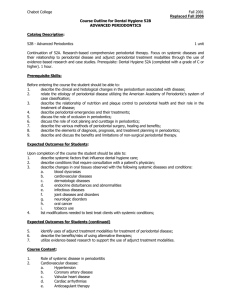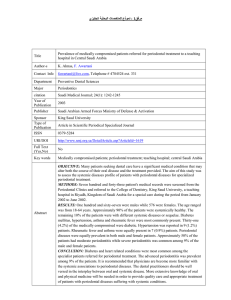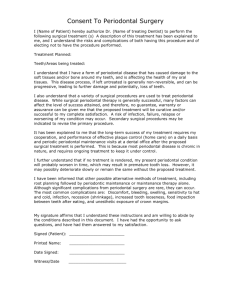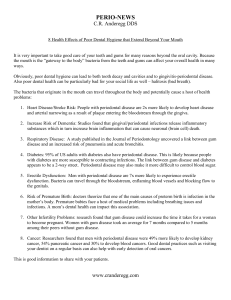Chabot College Fall 2008 52B - Advanced Periodontics
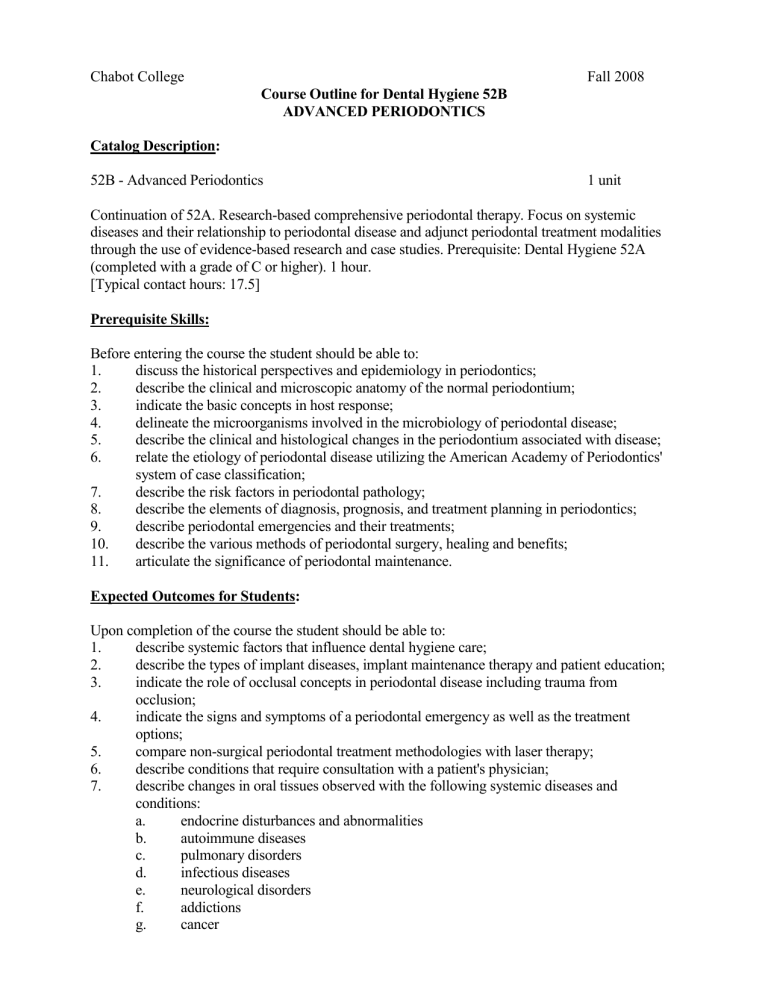
Chabot College
Catalog Description:
52B - Advanced Periodontics
Course Outline for Dental Hygiene 52B
ADVANCED PERIODONTICS
Fall 2008
1 unit
Continuation of 52A. Research-based comprehensive periodontal therapy. Focus on systemic diseases and their relationship to periodontal disease and adjunct periodontal treatment modalities through the use of evidence-based research and case studies. Prerequisite: Dental Hygiene 52A
(completed with a grade of C or higher). 1 hour.
[Typical contact hours: 17.5]
Prerequisite Skills:
Before entering the course the student should be able to:
1.
discuss the historical perspectives and epidemiology in periodontics;
2.
3.
4.
5.
6.
describe the clinical and microscopic anatomy of the normal periodontium; indicate the basic concepts in host response; delineate the microorganisms involved in the microbiology of periodontal disease; describe the clinical and histological changes in the periodontium associated with disease; relate the etiology of periodontal disease utilizing the American Academy of Periodontics' system of case classification;
7.
8.
describe the risk factors in periodontal pathology; describe the elements of diagnosis, prognosis, and treatment planning in periodontics;
9.
describe periodontal emergencies and their treatments;
10.
describe the various methods of periodontal surgery, healing and benefits;
11.
articulate the significance of periodontal maintenance.
Expected Outcomes for Students:
Upon completion of the course the student should be able to:
1.
2.
3.
describe systemic factors that influence dental hygiene care; describe the types of implant diseases, implant maintenance therapy and patient education; indicate the role of occlusal concepts in periodontal disease including trauma from occlusion;
4.
indicate the signs and symptoms of a periodontal emergency as well as the treatment
5.
6.
7.
options; compare non-surgical periodontal treatment methodologies with laser therapy; describe conditions that require consultation with a patient's physician; describe changes in oral tissues observed with the following systemic diseases and conditions: a.
b.
c.
d.
e.
f.
g.
endocrine disturbances and abnormalities autoimmune diseases pulmonary disorders infectious diseases neurological disorders addictions cancer
Chabot College
Course Outline for Dental Hygiene 52B, page 2
Fall 2008
8.
list modifications needed to best treat clients with systemic conditions;
Expected Outcomes for Students (continued)
9.
identify uses of adjunct treatment modalities for treatment of periodontal disease;
10.
describe the benefits/risks of using alternative therapies;
11.
utilize evidence-based research to support the use of adjunct treatment modalities.
Course Content:
1.
2.
3.
Role of systemic disease in periodontitis
Implant therapy and periodontal conditions
Periodontal emergencies
4.
5.
6.
7.
8.
9.
Occlusal concepts and occlusal trauma in periodontal therapy
The role of lasers in periodontal therapy
Cardiovascular disease and blood dyscrasias
Endocrine disturbances/abnormalities
Infectious diseases
Autoimmune disorders
10. Nutritional disorders
11. Pulmonary disorders
12. Neurological disorders
13. Cancer
14. Addictions
Methods of Presentation:
1.
2.
3.
Lecture
Discussion
Case studies
Assignments and Methods of Evaluating Student Progress:
1.
Typical Assignments a.
b.
Prepare a case documentation for a periodontal advanced case type.
Evaluate a research article focusing on periodontal therapy/treatment modalities.
2. Methods of Evaluating Student Progress a.
b.
Quizzes
Midterm examination c. Final examination
Textbook(s) (Typical):
Foundations of Periodontics for the Dental Hygienist, Nield-Gehrig Willmann, 2007 or most recent edition
Special Student Materials:
Removable storage media such as USB flash drive or diskette.
